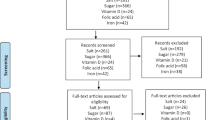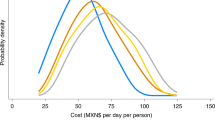Abstract
Background/Objective:
The World Health Organisation recommends governments to consider the use of fiscal policies to promote healthy eating. However, there is very limited evidence of the effect of food taxation in a real-life setting, as most evidence is based on simulation studies. The objective of this study is to evaluate the effect of the Danish tax on saturated fat in terms of changes in nutritional quality of the diet, that is, changes in saturated fat consumption, as well as other non-targeted dietary measures, and to model the associated changes in mortality for different age groups and genders.
Subjects/Methods:
On the basis of household scanner data, we estimate the impact of the tax on consumption of saturated fat, unsaturated fat, salt, fruit, vegetables and fibre. The resultant changes in dietary quality are then used as inputs into a comparative risk assessment model (PRIME (Preventable Risk Integrated ModEl)) to estimate the effect of these changes on non-communicable diseases (NCDs) and mortality.
Results:
The tax resulted in a 4.0% reduction in saturated fat intake. Vegetable consumption increased, and salt consumption increased for most individuals, except younger females. We find a modelled reduction in mortality with 123 lives saved annually, 76 of them below 75 years equal to 0.4% of all deaths from NCDs.
Conclusions:
Modelling the effect of the changes in diet on health outcomes suggests that the saturated fat tax made a positive, but minor, contribution to public health in Denmark
This is a preview of subscription content, access via your institution
Access options
Subscribe to this journal
Receive 12 print issues and online access
$259.00 per year
only $21.58 per issue
Buy this article
- Purchase on Springer Link
- Instant access to full article PDF
Prices may be subject to local taxes which are calculated during checkout
Similar content being viewed by others
References
Ezzati M, Lopez AD, Rodgers A, Vander Hoorn S, Murray CJL . Selected major risk factors and global and regional burden of disease. Lancet 2002; 360: 1347–1360.
WHO Global Status Report on Noncommunicable Diseases 2010. World Health Organization: Geneva, Switzerland, 2011: http://whqlibdoc.who.int/publications/2011/9789240686458_eng.pdf (last accessed November 2015).
WHO Health 2020: A European Policy Framework and Strategy for the 21st Century. WHO Regional Office for Europe: Copenhagen, Denmark, 2013. Available at: http://www.euro.who.int/en/publications/abstracts/health-2020.-a-european-policy-framework-and-strategy-for-the-21st-century (last accessed May 2015).
Wang H, Dwyer-Lindgren L, Lofgren KT, Rajaratnam JK, Marcus JR, Levin-Rector A et al. Age-specific and sex-specific mortality in 187 countries, 1970–2010: a systematic analysis for the Global Burden of Disease Study 2010. Lancet 2012; 380: 2071–2094.
IHME. Global Burden of Disease Visualisations. University of Washington Seattle, WA, USA, 2014. Available at: http://viz.healthmetricsandevaluation.org/gbd-compare/ (last accessed November 2015).
WHO Action Plan for Implementation of the European Strategy for the Prevention and Control of Noncommunicable Diseases 2012–2016. WHO Regional Office for Europe: Copenhagen, Denmark, 2012. Available at: http://www.euro.who.int/__data/assets/pdf_file/0019/170155/e96638.pdf (last ccessed May 2015).
WHO Prevention and Control of Non-Communicable Diseases in the European Region: A Progress Report. WHO Regional Office for Europe: Copenhagen, Denmark, 2014. Available at: http://www.euro.who.int/__data/assets/pdf_file/0004/235975/Prevention-and-control-of-noncommunicable-+diseases-in-the-European-Region-A-progress-report-Eng.pdf (last accessed June 2015).
WHO Global Strategy on Diet, Physical Activity and Health. WHO: Geneva, Switzerland, 2004.
WHO 2008–2013 Action Plan for the Global Strategy for the Prevention and Control of Noncommunicable Diseases. WHO: Geneva, Switzerland, 2008.
European Commission. EU Action Plan on Childhood Obesity 2014–2020. 2014. Available from: ( http://ec.europa.eu/health/nutrition_physical_activity/docs/childhoodobesity_actionplan_2014_2020_en.pdf (last accessed November 2015).
Bloomberg. (2013). Available at: http://www.bloomberg.com/news/2013-10-29/mexico-tackles-obesity-epidemic-with-tax-on-junk-food.html. (last accessed November 2015).
Smed S . Financial penalties on foods—the fat tax in Denmark. Nutr Bull 2012; 37 (2), 142–147.
Mytton O, Clarke D, Rayner M . Taxing unhealthy food and drinks to improve health. BMJ 2012; 344: e2931.
Epstein LH, Jankowiak N, Nederkoom C, Raynor HA, Frensh SA, Finkelstein E et al. Experimental research on the relationship between food price changes and food-purchasing patterns: a targeted review. Am J Clin Nutr 2012; 95: 789–809.
Eyles H, Ni Mhurchu C, Nghiem N, Blakely T . Food pricing strategies, population diets, and non-communicable disease: a systematic review of simulation studies. PLoS Med 2012; 9: e1001353.
Thow AM, Jan S, Leeder S, Swinburn B . The effect of fiscal policy on diet, obesity and chronic disease: a systematic review. Bull World Health Organ 2010; 88: 609–614.
Thow AM, Dows S, Jan S . A systematic review of the effectiveness of food taxes and subsidies to improve diets: understanding the recent evidence. Nutr Rev 2014; 72: 551–565.
Jensen JD, Smed S . The Danish tax on saturated fat—short run effects on consumption, substitution patterns and consumer prices of fats. Food Policy 2013; 42: 18–31.
Jensen JD, Smed S, Aarup L, Nielsen E . Effect of the Danish saturated fat tax on the demand for meat and dairy products. Public Health Nutr 2015, e-pub ahead of print 26 August 2015; doi:1017/S1368980015002360.
Bahl R, Bird R, Walker M . The uneasy case against discriminatory excise taxation: soft drink taxes in Ireland. Public Fin Rev 2003; 31: 510.
Smed S, Robertson A . Are taxes on fatty foods having the desired health impact? BMJ 2012; 345: e6885.
Scarborough P, Harrington RA, Mizdrak A, Zhou LM, Doherty A . The Preventable Risk Integrated ModEl (PRIME) and its use to estimate the health impact of public health policy scenarios. Scientifica 2014; e-pub ahead of print 25 September 2014; doi:10.1155/2014/748750.
Briggs A, Mytton O, Kehlbacher A, Tiffin R, Rayner M et al. The overall and income specific effect on the prevalence of overweight and obesity of a 20% sugar sweetened beverage tax in the UK: an econometric and comparative risk assessment modelling study. BMJ 2013b; 347: f6189.
Scarborough P, Allender S, Clarke D, Wickramasinghe K, Rayner M . Modelling the health impact of environmentally sustainable dietary scenarios in the UK. Eur J Clin Nutr 2012; 66: 710–715.
Scarborough P, Nnoaham K, Clarke D, Rayner M, Capewell S . Modelling the impact of a healthy diet on cardiovascular disease and cancer mortality. J Epidemiol Commun Health 2012; 66: 420–426.
Scarborough P, Morgan R, Webster P, Rayner M . Differences in coronary heart disease, stroke andcancer mortality rates between England, Scotland, Wales and Northern Ireland: the role of diet and nutrition. BMJ Open 2011; 1; doi:10.1136/bmjopen-2011-000263.
Briggs A, Mytton O, Madden D, O’Shea D, Rayner M, Scarborough P et al. The impact on obesity of a 10% tax on sugar-sweetened beverages in Ireland, a comparative risk assessment modelling study. BMC Public Health 2013; 13: 860.
Belanger M, Poireir M, Jbilou J, Scarborough P . Modelling impact of compliance with dietary recommendations on cancer and cardiovascular disease mortality in Canada. Public Health 2014; 128: 222–230.
Irz X, Leroy P, Requillart V, Soler L-G Economic assessment of nutritional recommendations. Working paper No. TSE-473, Toulouse School of Economics, Toulouse, France 2014.
Pedersen AN, Fagt S, Groth MV, Christensen T, Biltoft-Jensen AP, Matthiessen J et al. Danskernes kostvaner 2003–2008: hovedresultater. Danmarks Tekniske Universitet, Fødevareinstituttet: Mørkhøj, Copenhagen, Denmark.
Mytton O, Nnoaham K, Eyles H, Scarborough P, Ni Mhurchu C . Systematic review and meta-analysis of the effect of increased fruit and vegetable consumption on body weight and energy intake. BMC Public Health 2014; 14: 886.
Vallgårda S, Holm L, Jensen JD . The Danish tax on saturated fat: why did it not survive? Eur J Clin Nutr 2015; 69: 223–226.
Singh RB, Rastogi SS, Niaz MA, Ghosh S, Singh R, Gupta S et al. Effect of fat-modified and fruit- and vegetable-enriched diets on blood lipids in the Indian Diet Heart Study. Am J Cardiol 1992; 70: 869–874.
Kaiser KA, Brown AW, Brown MMB, Shikany JM, Mattes RD, Allison DB et al. Increased fruit and vegetable intake has no discernible effect on weight loss: a systematic review and meta-analysis. Am J Clin Nutr 2014; 100: 567–576.
Weerts SE, Amoran A . Pass the fruits and vegetables! A community–university–industry partnership promotes weight loss in African American women. Health Promot Pract 2011; 12: 252–260.
Whybrow S, Harrison CLS, Mayer C, Stubbs RJ . Effects of added fruits and vegetables on dietary intakes and body weight in Scottish adults. Br J Nutr 2007; 95: 496.
WRAP. Household Food and Drink Waste in the United Kingdom. WRAP: London, UK, 2012.
Chowdhury R, Warnakula S, Kunutsor S, Crowe F, Ward HA, Johnson LO et al. Association of dietary, circulating, and supplement fatty acids with coronary risk: a systematic review and meta-analysis. Ann Intern Med 2014; 160: 398–406.
Siri-Tarino P, Sun Q, Hu F, Krauss R . Meta-analysis of prospective cohort studies evaluating the association of saturated fat with cardiovascular disease. Am J Clin Nutr 2010; 91: 535–546.
Scarborough P, Rayner M, van Dis I, Norum K . Meta-analysis of effect of saturated fat intake on cardiovascular disease: over adjustment obscures true associations. Am J Clin Nutr 2010; 92, 458–459.
Blakely T, A new review on dietary fats: putting its findings in context. BLOG https://blogs.otago.ac.nz/pubhealthexpert/2014/03/18/a-new-review-on-dietary-fats-putting-its-findings-in-context/ (last accessed November 2015).
Stamler J . Diet-heart: a problematic revisit. Am J Clin Nutr 2010; 91: 497–499.
Mozaffarian D, Micha R, Wallace S . Effects on coronary heart disease of increasing polyunsaturated fat in place of saturated fat: a systematic review and meta-analysis of randomized controlled trials. PLoS Med 2010; 7: e1000252.
Clarke R, Frost C, Collins R, Appleby P, Peto R . Dietary lipids and blood cholesterol: quantitative analysis of metabolic ward studies. BMJ 1997; 314: 112–117.
PSC, Prospective Studies Collaboration. Blood cholesterol and vascular mortality by age, sex, and blood pressure: a meta‐analysis of individual data from 61 prospective studies with 55000 vascular deaths. Lancet 2007; 370: 1829‐1840.
Jakobsen MU, O’Reilly EJ, Heitmann BL, Pereira MA, Balter K, Fraser GE et al. Major types of dietary fat and risk of coronary heart disease: a pooled analysis of 11 cohort studies. Am J Clin Nutr 2009; 89: 1425–1432.
Author information
Authors and Affiliations
Corresponding author
Ethics declarations
Competing interests
None of the authors have financial relationships with any organisation that might have had an interest in the submitted work in the previous 3 years and no other relationships or activities that could appear to have influenced the submitted work. The authors declare no conflict of interest.
Additional information
Author contributions
SS and JDJ were responsible for the econometric modelling. MR and PS were responsible for the NCD modelling. All authors contributed equally to the design and writing of the paper.
Supplementary Information accompanies this paper on European Journal of Clinical Nutrition website
Supplementary information
Rights and permissions
About this article
Cite this article
Smed, S., Scarborough, P., Rayner, M. et al. The effects of the Danish saturated fat tax on food and nutrient intake and modelled health outcomes: an econometric and comparative risk assessment evaluation. Eur J Clin Nutr 70, 681–686 (2016). https://doi.org/10.1038/ejcn.2016.6
Received:
Revised:
Accepted:
Published:
Issue Date:
DOI: https://doi.org/10.1038/ejcn.2016.6
This article is cited by
-
Development towards low carbon and sustainable agriculture in Finland is possible with moderate changes in land use and diets
Sustainability Science (2023)
-
Food system development pathways for healthy, nature-positive and inclusive food systems
Nature Food (2021)
-
Do taxes on unhealthy foods and beverages influence food purchases?
Current Nutrition Reports (2021)
-
Getting the Price Right: How Nutrition and Obesity Prevention Strategies Address Food and Beverage Pricing Within High-Income Countries
Current Nutrition Reports (2020)
-
Social marketing including financial incentive programs at worksite cafeterias for preventing obesity: a systematic review
Systematic Reviews (2019)



